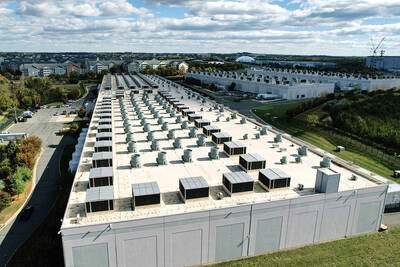The New Taiwan dollar and Taiwanese stocks surged on signs that trade tensions between the world’s top two economies might start easing and as US tech earnings boosted the outlook of the nation’s semiconductor exports.
The NT dollar strengthened as much as 3.8 percent versus the US dollar to 30.815, the biggest intraday gain since January 2011, closing at NT$31.064. The benchmark TAIEX jumped 2.73 percent to outperform the region’s equity gauges.
Outlook for global trade improved after China said it is assessing possible trade talks with the US, providing a boost for the nation’s currency and shares. As the NT dollar appreciated, local exporters rushed to convert US dollars to the currency, while typical buyers of the greenback stepped back from the market, creating a feedback loop that exaggerated the move, traders said.

Photo: CNA
Still, there was no aggressive or abnormal intervention by the central bank, traders said. The monetary authority usually intervenes to iron out volatility amid wild swings in the currency market.
“The faster-than-expected pace of Taiwan dollar appreciation caught many market participants off guard, prompting a rush to convert US dollars into local currency,” Oversea-Chinese Banking Corp foreign exchange strategist Christopher Wong (黃經隆) said in Singapore. “The recent Taiwan dollar gains have also been catalyzed by prospects of dialog between US and China.”
The NT dollar’s rally has propelled it to the top of emerging Asian currency rankings this year, with a gain of nearly 6 percent versus the greenback. Other Asian currencies have also advanced amid the trade optimism, with the South Korean won and the Indonesian rupiah up more than 1 percent yesterday.
The surge in the NT dollar is backed by the largest volumes for greenback-NT dollar non-deliverable forwards, which are making a rare appearance at the top of global trading charts.
The central bank said it has not received any request from the US Department of the Treasury to push for an appreciation of Taiwan's currency, amid speculation fueled by the NT dollar's recent sharp rise against the greenback.
In a statement released on Thursday, the central bank refuted local media reports suggesting Washington had exerted pressure on Taiwan to allow its currency to strengthen.
The reports cited the so-called "Mar-a-Lago Accord" under US President Donald Trump, claiming the US had sought "reciprocal" tariffs and currency adjustments in negotiations with trading partners.
In response to the rapid appreciation of the NT dollar, Premier Cho Jung-tai (卓榮泰) said yesterday that the foreign exchange rate is largely dictated by international market conditions, and that the government did not come under any pressure to push up the local currency's value.
Cho emphasized the value of the NT dollar is decided by a market mechanism.
For Taiwanese stocks, strong US tech earnings are a significant driver, as Microsoft Corp and Meta Platforms Inc led "Magnificent Seven" stocks higher on Thursday.
“Microsoft and Meta’s capex came better than expected, suggesting that the AI [artificial intelligence] demand remains strong, which will benefit overall chip demand and Taiwan Semiconductor Manufacturing Co’s (台積電) revenue,” GF Holdings Hong Kong Corp (廣發控股) analyst Jeff Pu (蒲得宇) said in Hong Kong.
He sees expectations for softness in the US economy to weigh on the greenback and benefit the NT dollar.
Additional reporting by CNA

Taiwan’s exports soared 56 percent year-on-year to an all-time high of US$64.05 billion last month, propelled by surging global demand for artificial intelligence (AI), high-performance computing and cloud service infrastructure, the Ministry of Finance said yesterday. Department of Statistics Director-General Beatrice Tsai (蔡美娜) called the figure an unexpected upside surprise, citing a wave of technology orders from overseas customers alongside the usual year-end shopping season for technology products. Growth is likely to remain strong this month, she said, projecting a 40 percent to 45 percent expansion on an annual basis. The outperformance could prompt the Directorate-General of Budget, Accounting and

The demise of the coal industry left the US’ Appalachian region in tatters, with lost jobs, spoiled water and countless kilometers of abandoned underground mines. Now entrepreneurs are eyeing the rural region with ambitious visions to rebuild its economy by converting old mines into solar power systems and data centers that could help fuel the increasing power demands of the artificial intelligence (AI) boom. One such project is underway by a non-profit team calling itself Energy DELTA (Discovery, Education, Learning and Technology Accelerator) Lab, which is looking to develop energy sources on about 26,305 hectares of old coal land in

Netflix on Friday faced fierce criticism over its blockbuster deal to acquire Warner Bros Discovery. The streaming giant is already viewed as a pariah in some Hollywood circles, largely due to its reluctance to release content in theaters and its disruption of traditional industry practices. As Netflix emerged as the likely winning bidder for Warner Bros — the studio behind Casablanca, the Harry Potter movies and Friends — Hollywood’s elite launched an aggressive campaign against the acquisition. Titanic director James Cameron called the buyout a “disaster,” while a group of prominent producers are lobbying US Congress to oppose the deal,

Two Chinese chipmakers are attracting strong retail investor demand, buoyed by industry peer Moore Threads Technology Co’s (摩爾線程) stellar debut. The retail portion of MetaX Integrated Circuits (Shanghai) Co’s (上海沐曦) upcoming initial public offering (IPO) was 2,986 times oversubscribed on Friday, according to a filing. Meanwhile, Beijing Onmicro Electronics Co (北京昂瑞微), which makes radio frequency chips, was 2,899 times oversubscribed on Friday, its filing showed. The bids coincided with Moore Threads’ trading debut, which surged 425 percent on Friday after raising 8 billion yuan (US$1.13 billion) on bets that the company could emerge as a viable local competitor to Nvidia